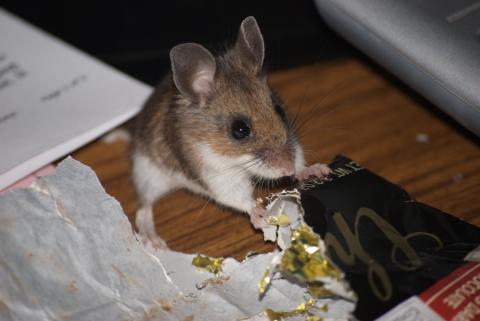How Can I Get Rid of the Mice in My House?

Now that cooler fall weather has finally arrived, many mice are looking for a protected place to spend the winter, and our warm homes present the perfect habitat. Mice are often one of the biggest pest concerns indoors because they eat and contaminate food items, cause damage to homes , and carry some diseases that are transmissible to people. Tolerating the presence of mice is simply not an option for the majority of homeowners.
It is very possible to have mice in your home but never physically see them. They are most active at night, which is when they move about and do the majority of their feeding. What is more evident is the results of their foraging. Be on the lookout for droppings (1/8 – 1/4 inches long, dark and pointed at both ends) and damage to food items or materials used for nesting (such as linens or home insulation). While these signs are an obvious indication that control efforts are warranted, you don’t need to wait until you see physical evidence of mice to take action, particularly if you have had issues with them in the past.
Tips for Controlling Mice in your Home
Start with Mouse Access Routes
The best way to start any mouse control effort is to keep them from getting inside to begin with. This means sealing up all exterior cracks around the house, paying special attention to the foundation and where pipes and utilities enter the home. To be certain, fill any gaps that are larger than ¼ inch as mice are capable of squeezing their bodies through impossibly small openings.
Keep Food Items Secure
Practicing good sanitation is the next step. Mice have a keen sense of smell and are drawn to spilled or exposed food items, including birdseed. A good way to prevent them from becoming a nuisance is to make sure these items aren’t accessible. Promptly clean-up all spills and keep stored foods in closed cabinets or tightly-lidded containers. For safety, throw away any food that has been contaminated by or damaged by mice.
If All Else Fails, Trapping May be Necessary
If mice are still an issue after efforts have been made to exclude them from the house, it’s time to try trapping. Many different trap styles are available, with varying degrees of effectiveness. Snap traps are inexpensive and work very well if they are placed against walls or in protected areas that mice frequent. Rodenticides are another option but should be treated with extreme care. Trapping is preferred over rodenticides because it eliminates the risk of accidental poisoning of children and pets, and keeps track of dead mice. Poisoned mice may die out of sight and cause odors or be eaten by other animals, sickening them.
.jpg)
When it comes to disposal, it’s always a good idea to wear gloves when handling dead mice or their droppings.
Got questions? The Ask UNH Extension Infoline offers practical help finding answers for your home, yard, and garden questions. Call toll free at 1-877-398-4769, Monday to Friday, 9 a.m. to 2 p.m., or e-mail us at answers@unh.edu.
Related Resource(s)
Do you love learning about stuff like this?
SUBSCRIBE TO Granite State Gardening newsletter
Got questions? The UNH Extension Yard and Garden Infoline offers practical help finding answers for your yard and garden questions.
Call toll free at 1-877-398-4769, Monday to Friday, 9 a.m. to 2 p.m., or fill out webform.
